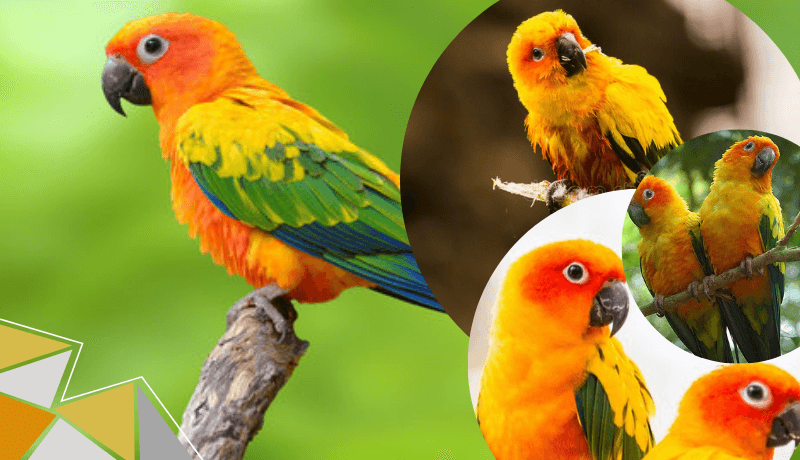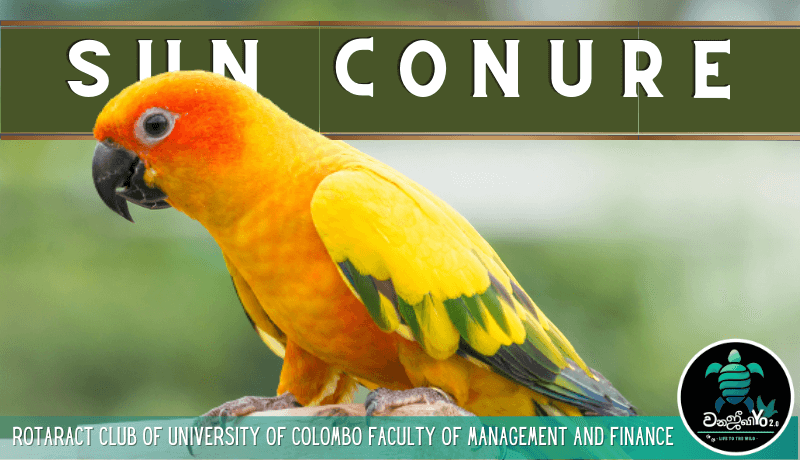General
The Sun Conure is commonly referred to as the Sun Parakeet. They are prevalent and well-liked in the pet industry. These sociable parrots frequently gather in boisterous packs of up to thirty birds. If properly cared for and protected from accidents, captive Sun Conures can survive for 20 to 30 years.
Distribution and habitat
It is a parrot indigenous to the northeastern coastal forests of South America, more notably northeastern Brazil and Guyana. They were believed to occur in French Guiana, Suriname, and eastern Venezuela.
Appearance
they are known as “the most beautiful of neotropical parrots”. Adults are about 30 cm long and weigh between 100 and 123 g. The wings are between 146 and 162 mm long, and the bill is 19 and 25 mm long. Both adults are generally deep yellow, with varying orange tints on the forehead, sides of the head, lower abdomen, rump, and lower back. Green under tail coverts are yellow-tinted.
Diet
They feed fruits, flowers, berries, seeds, nuts, and the occasional insect.
Threats
This species is imperiled within its native range due to habitat degradation and trapping for the pet trade. Their populations are dwindling, and in many areas of their historical range, they are now extremely rare or nonexistent. They typically don’t live very long in the wild because of predators, mishaps, and unfavorable environmental/climatic circumstances.

සාමාන්ය
සන් කෝනියර් ගිරවා සාමාන්යයෙන් හඳුන්වන්නේ සන් පැරකීට් ලෙසයි. ඔවුන් සුරතල් කර්මාන්තයේ බහුල වේ. මෙම සමාජශීලී ගිරවුන් තිහක් පමණ රංචු ලෙස නිතර රැස්වේ. නිසි ලෙස රැකබලා ගැනීමෙන් සහ අනතුරු වලින් ආරක්ෂා වුවහොත්, සන් කෝනියර් ගිරවන් වසර 20 සිට 30 දක්වා ජීවත් විය හැකිය.
පැතිරීම සහ වාසස්ථාන
දකුණු ඇමරිකාවේ ඊසානදිග වෙරළබඩ වනාන්තරවලට, විශේෂයෙන් ඊසානදිග බ්රසීලයට ආවේණික වූ ගිරවෙකි. සුරිනාම් සහ නැගෙනහිර වෙනිසියුලාවේ ඇති බවට විශ්වාස කෙරේ.
පෙනුම
ඔවුන් නියෝට්රොපිකල් ගිරවුන්ගෙන් ලස්සනම ගිරවා ලෙස හැඳින්වේ. වැඩිහිටියන් සෙන්ටිමීටර 30 ක් පමණ දිග සහ ග්රෑම් 100 ත් 123 ත් අතර බරකින් යුක්ත වේ. පියාපත් 146 ත් 162 ත් අතර දිගකින් යුක්ත වන අතර බිල්පත මිලිමීටර් 19 ත් 25 ත් අතර වේ. වැඩිහිටියන් දෙදෙනාම පොදුවේ කහ පැහැයෙන් යුක්ත වන අතර, නළල, හිස දෙපස, පහළ උදරය, කඹය සහ පහළ පිටුපස විවිධ තැඹිලි පැහැති ය. වලිගය යට කොළ කහ පැහැයෙන් යුක්ත වේ.
ආහාර වේල
ඔවුන් පලතුරු, මල්, බෙරි, බීජ, ඇට වර්ග සහ ඉඳහිට කෘමීන් පෝෂණය කරයි.
තර්ජන
වාසස්ථාන හායනය සහ සුරතල් වෙළඳාම සඳහා උගුල් ඇල්ලීම හේතුවෙන් මෙම විශේෂය ස්වදේශීය පරාසය තුළම විනාශ වී ඇත. ඔවුන්ගේ ජනගහනය අඩුවෙමින් පවතින අතර, ඔවුන්ගේ ඓතිහාසික පරාසයේ බොහෝ ප්රදේශවල, දැන් අතිශයින් දුර්ලභ හෝ නොපවතියි. විලෝපිකයන්, අනතුරු සහ අහිතකර පාරිසරික/දේශගුණික තත්ත්වයන් නිසා ඔවුන් සාමාන්යයෙන් වැඩි කාලයක් වනයේ ජීවත් නොවේ.

பொது
சன் கோனூர் பொதுவாக சூரியக் கிளி என்று குறிப்பிடப்படுகிறது. அவை செல்லப்பிராணி தொழிலில் பரவலாக நன்கு விரும்பப்பட்டவர்களாகவும் உள்ளன. இவை முப்பது பறவைகள் வரை அடிக்கடி கொந்தளிப்பான பொதிகளில் சேகரிக்கின்றன. சரியான முறையில் பராமரிக்கப்பட்டு, விபத்துகளில் இருந்து பாதுகாக்கப்பட்டால், சிறைபிடிக்கப்பட்ட சன் கோனூர்ஸ் 20 முதல் 30 ஆண்டுகள் வரை உயிர்வாழும்.
விநியோகம் மற்றும் வாழ்விடம்
இது தென் அமெரிக்காவின் வடகிழக்கு கடலோர காடுகளுக்கு, குறிப்பாக வடகிழக்கு பிரேசில் மற்றும் கயானாவில் உள்ள ஒரு கிளி. அவை பிரெஞ்சு கயானா, சுரினாம் மற்றும் கிழக்கு வெனிசுலாவில் ஏற்பட்டதாக நம்பப்படுகிறது.
தோற்றம்
அவை “நியோட்ரோபிகல் கிளிகளில் மிக அழகானவை” என்று அழைக்கப்படுகின்றன. பெரியவர்கள் சுமார் 30 செ.மீ நீளமும் 100 முதல் 123 கிராம் வரை எடையும் கொண்டன. இறக்கைகள் 146 மற்றும் 162 மிமீ நீளமும், பில் 19 முதல் 25 மிமீ நீளமும் இருக்கும். இரு பெரிய பறவைகளும் பொதுவாக மஞ்சள் நிறத்தில் உள்ளன, நெற்றியில், தலையின் ஓரங்களில், கீழ் வயிறு, ரம்ப் மற்றும் கீழ் முதுகில் பல்வேறு ஆரஞ்சு நிறங்கள் இருக்கும். வால் மூடியின் கீழ் பச்சை மஞ்சள் நிறமாக இருக்கும்.
உணவுமுறை
அவை பழங்கள், பூக்கள், பெர்ரி, விதைகள், கொட்டைகள் மற்றும் அவ்வப்போது பூச்சிகளுக்கு உணவளிக்கின்றன.
அச்சுறுத்தல்கள்
வாழ்விட சீரழிவு மற்றும் செல்லப்பிராணி வர்த்தகத்தின் காரணமாக இந்த இனம் அதன் சொந்த வரம்பிற்குள் பாதிக்கப்படுகிறது. இவைகளின் பறவை மக்கள்தொகை குறைந்து வருகிறது, மேலும் இவைகளின் வரலாற்று வரம்பின் பல பகுதிகளில், இவை இப்போது மிகவும் அரிதானவை அல்லது இல்லாதவை. வேட்டையாடுபவர்கள், விபத்து மற்றும் சாதகமற்ற சுற்றுச்சூழல்/காலநிலை காரணமாக இவை பொதுவாக காடுகளில் நீண்ட காலம் வாழ்வதில்லை.


